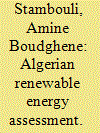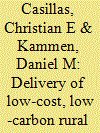|
|
|
Sort Order |
|
|
|
Items / Page
|
|
|
|
|
|
|
| Srl | Item |
| 1 |
ID:
107624


|
|
|
|
|
| Publication |
2011.
|
| Summary/Abstract |
Algeria plays a very important role in world energy markets, both as a significant hydrocarbon producer and as an exporter, as well as a key participant in the renewable energy market. Due to its geographical location, Algeria holds one of the highest solar potentials in the world. This paper presents a review of the present renewable energy situation and assesses present and future potential of renewable energy sources (RESs) in Algeria. This paper also discusses the trends and expectation in solar systems applications and the aspects of future implementation of renewable energies in the Middle East and North Africa (MENA) region status. The problem related to the use of RES and polices to enhance the use of these sources are also analysed in this paper. In addition the available capacity building, the technical know-how for each RES technology and localizing manufacturing of renewable energy equipments are defined. The co-importance of both policy and technology investments for the future Algerian markets of RES and competitiveness of the solar/wind approach is emphasized. Some examples of policy significantly impacting Algerian markets are reviewed, and the intention of the new Algerian RES initiative is discussed.
|
|
|
|
|
|
|
|
|
|
|
|
|
|
|
|
| 2 |
ID:
107631


|
|
|
|
|
| Publication |
2011.
|
| Summary/Abstract |
Biomass co-firing systems in power plants generate electric power by the simultaneous combustion of biomass and fossil fuels. The co-firing process reduces investment costs by converting biomass energy into electricity in existing conventional power plants. Biomass co-firing significantly reduces carbon dioxide and sulfur dioxide emissions in power generation. To meet the increase in biomass demand, this paper has considered systematic energy crop production, which is expected to increase in the near future. Our aim is to analyze biomass co-firing systems in the Taiwanese electricity market. In this paper, we study two emerging biomass feedstocks: switchgrass and Miscanthus. We focus on the impact of energy crop co-firing on carbon dioxide and sulfur dioxide emissions for electricity generation. A Nash-Cournot competition model, which simulates potential biomass co-firing scenarios, is formulated for power markets. A case study conducted in the Taiwanese electricity market showed that biomass co-firing lowers total electricity demand and sale. Miscanthus is more economical than switchgrass in terms of the production cost and the land required to generate biopower for the same levels of biomass co-firing.
|
|
|
|
|
|
|
|
|
|
|
|
|
|
|
|
| 3 |
ID:
107627


|
|
|
|
|
| Publication |
2011.
|
| Summary/Abstract |
China has implemented a series of minimum energy performance standards (MEPS) for over 30 appliances, voluntary energy efficiency label for 40 products, and a mandatory energy information label that covers 19 products to date. However, the impact of these programs and their savings potential has not been evaluated on a consistent basis. This paper uses modeling to estimate the energy saving and CO2 emission reduction potential of the appliances standard and labeling program for products for which standards are currently in place, under development or those proposed for development in 2010 under three scenarios that differ in the pace and stringency of MEPS development. In addition to a baseline "frozen efficiency" scenario at 2009 MEPS level, the "Continued Improvement Scenario" (CIS) reflects the likely pace of post-2009 MEPS revisions, and the likely improvement at each revision step. The "Best Practice Scenario" (BPS) examined the potential of an achievement of international best-practice efficiency in broad commercial use today in 2014. This paper concludes that under "CIS", cumulative electricity consumption could be reduced by 9503 TWh, and annual CO2 emissions of energy used for all 37 products would be 16% lower than in the frozen efficiency scenario. Under a "BPS" scenario for a subset of products, cumulative electricity savings would be 5450 TWh and annual CO2 emissions reduction of energy used for 11 appliances would be 35% lower.
|
|
|
|
|
|
|
|
|
|
|
|
|
|
|
|
| 4 |
ID:
107520


|
|
|
| 5 |
ID:
107630


|
|
|
|
|
| Publication |
2011.
|
| Summary/Abstract |
Within the EU, there have been calls for governments to provide greater certainty over carbon prices, even though it is evident that their price risk is not entirely due to policy uncertainty. We develop a stochastic simulation model of price formation in the EU ETS to analyse the coevolution of policy, market and technology risks under different initiatives. The current situation of a weak (20%) overall abatement target motivates various technology-support interventions, elevating policy uncertainty as the major source of carbon price risk. In contrast, taking a firm decision to move to a more stringent 30% cap would leave the EU-ETS price formation driven much more by market forces than by policy risks. This leads to considerations of how much risk mitigation by governments would be appropriate, and how much should be taken as business risk by the market participants.
|
|
|
|
|
|
|
|
|
|
|
|
|
|
|
|
| 6 |
ID:
107625


|
|
|
|
|
| Publication |
2011.
|
| Summary/Abstract |
The provision of both electrical and mechanical energy services can play a critical role in poverty alleviation for the almost two billion rural users who currently lack access to electricity. Distributed generation using diesel generators remains a common means of electricity provision for rural communities throughout the world. Due to rising fuel costs, the need to address poverty, and consequences of global warming, it is necessary to develop cost efficient means of reducing fossil fuel consumption in isolated diesel microgrids. Based on a case study in Nicaragua, a set of demand and supply side measures are ordered by their annualized costs in order to approximate an energy supply curve. The curve highlights significant opportunities for reducing the costs of delivering energy services while also transitioning to a carbon-free electrical system. In particular, the study demonstrates the significant cost savings resulting from the implementation of conventional metering, efficient residential lighting, and electricity generation using renewable energy sources.
|
|
|
|
|
|
|
|
|
|
|
|
|
|
|
|
| 7 |
ID:
107635


|
|
|
|
|
| Publication |
2011.
|
| Summary/Abstract |
This paper provides empirical evidence on the changing structure of world oil price system by identifying an additional driver-emerging market factor. We choose China and India as a representative of emerging markets to examine if the quantity of crude oil imported by China and India is significant in the existing oil pricing system (Kaufmann et al., 2004). Our data starts from January 2002 and ends in March 2010, which includes the oil shock of 2007-2008. We utilize cointegration and error correction model framework developed by Engle-Granger (1987) and Gregory-Hansen (1996) in the analysis. Our results indicate that demand from emerging markets has become a significant factor in the world oil pricing system since 2003. This result is significant as it lends empirical support to the widely held conjecture that the oil shock of 2007-2008 is a demand-led shock (Hamilton, 2009). Our result also has significant policy implications that go beyond the oil shock. The emerging market factor is there to stay and reflects the changing power between emerging and developed economies in the world economic system as a result of decades of fast economic development in the former. It will certainly influence policy issues related to oil and beyond.
|
|
|
|
|
|
|
|
|
|
|
|
|
|
|
|
| 8 |
ID:
107527


|
|
|
|
|
| Publication |
2011.
|
| Summary/Abstract |
Addressing issues of renewable energy in North Africa must incorporate concerns regarding the compatibility of energy mixes with the nature of political regimes, their geopolitical relevance, and their socio-economic effects, in addition to economic cost-benefit deliberations. One important and under-researched aspect of nuclear energy refers to the trade-off between socio-economic development and political power conservation. Competing interests in North Africa's energy market as well as aspects of regional cooperation capacity are important when assessing the choice between renewable and nuclear energy. Therefore, the future course of meeting North Africa's energy needs is subject to a complex political and economic interplay between domestic and geopolitical development interests. The objective of this paper is to explore this complexity in more detail. We argue that the identification of any energy alternative as superior is hardly convincing unless certain standards of inclusive governance are met. We also find that it is important to highlight political-economic differences between energy importers like Morocco and Tunisia and energy exporters like Algeria, Libya, and Egypt.
|
|
|
|
|
|
|
|
|
|
|
|
|
|
|
|
| 9 |
ID:
107633


|
|
|
|
|
| Publication |
2011.
|
| Summary/Abstract |
As with any other bioenergy product, bioethanol production requires fossil fuel inputs; hence the alleged benefits of energy security and carbon mitigation depend on the extent to which these inputs are capable of drawing a substantive bioenergetic yield. Brazilian ethanol, made out of sugarcane, has been reported as the most efficient gasoline substitute that is commercially available nowadays. For that reason it has been the object of several analyses on the energetics, i.e. energy balances. These studies surprisingly vary widely according with the scholar approach and are not fully comparable among them due to divergences in the assessment method.
This paper standardises results of the four most prominent authors in the field, establishing a point of comparison and drawing some light on the energetics studies on biofuels. The main result is shown in Table 5, which homogenises the outcomes for referred studies in terms of unit of assessment in the energy input analysis. Subsequently, this information is also charted (Fig. 2) explaining the source of divergence among authors.
This work ends with a short reference and comparison to some energy balance studies carried out on feedstocks of diverse nature, highlighting the potential that sugarcane-based bioethanol represents nowadays.
|
|
|
|
|
|
|
|
|
|
|
|
|
|
|
|
| 10 |
ID:
107639


|
|
|
|
|
| Publication |
2011.
|
| Summary/Abstract |
In this paper we discuss issues involving energy security with economic growth and development that brings out (i) the dimension of physical security alternative, (ii) framework for a pan South East Asian platform to support energy security and (iii) requirement of promoting regional energy cooperation and specific energy peace initiatives. Sustaining projected economic growth rate coupled with energy security in future is a concern for all developing countries like India. The energy security of these nations is threatened by the disruption of energy supplies by ongoing energy terrorism and geopolitical conflicts in the region. India's geo-strategic position and increasing energy dependence raises concerns for its energy security. We discuss energy security, examine factors and approaches to attempt the energy security in the light of economic growth and development.
|
|
|
|
|
|
|
|
|
|
|
|
|
|
|
|
| 11 |
ID:
107641


|
|
|
|
|
| Publication |
2011.
|
| Summary/Abstract |
We thank Brathwaite et al. for starting a very useful debate about what role, if any, coal should play in future energy transitions. Expanding upon their piece, we question that a coal-based economy, in which energy production for both electricity and transport comes from coal, can meet the energy security needs of the United States and other countries.
|
|
|
|
|
|
|
|
|
|
|
|
|
|
|
|
| 12 |
ID:
107500


|
|
|
|
|
| Publication |
2011.
|
| Summary/Abstract |
Greenhouse gas (GHG) emissions from reservoirs have been under the microscope for more a decade now. In particular, the high CH4 emissions reported in warm systems have tarnished the green credentials of hydroelectricity in terms of GHG emissions. Reliable estimates of CH4 emissions are crucial, since CH4 has a greenhouse warming potential of 25 and because, unlike CO2, CH4 emissions should be counted for the entire life cycle of a reservoir. Up to now, the highest CH4 emissions from reservoirs have been measured in warm latitudes, thus adding an argument against the use of hydroelectricity in these regions. However, to our knowledge, GHG emissions have been measured for only 18 of the 741 large dams (>10 MW, according to the ICOLD register) listed in the tropics. This article reviews the limited scientific information available and concludes that, at this time, no global position can be taken regarding the importance and extent of GHG emissions in warm latitudes.
|
|
|
|
|
|
|
|
|
|
|
|
|
|
|
|
| 13 |
ID:
107525


|
|
|
|
|
| Publication |
2011.
|
| Summary/Abstract |
The North African countries Morocco, Algeria, Tunisia, Libya and Egypt have been and are currently experiencing rapid growth in energy demand. This development confronts their political leaders with the question of how to expand or diversify their countries' generation capacities. In this context, renewable energies and nuclear power constitute options that have rarely been exploited so far in the region. This article analyzes the drawbacks and benefits of both alternatives, with a special focus on import and export dynamics. When attempting to make the strategic decision between renewables and atomic power, North African regional specifics and circumstances have to be taken into account. Hence, in a first step, the article characterizes the energy systems of the North African countries and presents scenarios for their future development. In a second step, it scrutinizes the energy challenges these states face in terms of domestic concerns and foreign affairs. Finally, a case study of Algeria is used to demonstrate how renewable energies, but not nuclear power, are able to respond to North African energy challenges.
|
|
|
|
|
|
|
|
|
|
|
|
|
|
|
|
| 14 |
ID:
107528


|
|
|
|
|
| Publication |
2011.
|
| Summary/Abstract |
The idea to use the sun of the Sahara for European energy needs is simple to conceive, but not so simple to implement. This article reviews one tool in the arsenal of methods to come nearer to that goal-virtual trading using flexibility mechanisms. Flexibility mechanisms are established under the Kyoto Protocol and available in EU legislation. But restrictions exist and market forces, mostly generated by national emissions reduction obligations under climate policy, do not necessarily act in favor of renewable energy imports into Europe. The paper assesses the current situation, in view of EU member states' recently published positions on the use of flexibility mechanisms for cross-border trade.
|
|
|
|
|
|
|
|
|
|
|
|
|
|
|
|
| 15 |
ID:
107634


|
|
|
|
|
| Publication |
2011.
|
| Summary/Abstract |
Large integration of intermittent wind generation in power system has necessitated the inclusion of more innovative and sophisticated approaches in power system investment planning. This paper presents a novel framework on the basis of a combination of stochastic dynamic programming (SDP) algorithm and game theory to study the impacts of different regulatory interventions to promote wind power investment in generation expansion planning. In this study, regulatory policies include Feed-in-Tariff (FIT) incentive, quota and tradable green certificate. The intermittent nature and uncertainties of wind power generation will cause the investors encounter risk in their investment decisions. To overcome this problem, a novel model has been derived to study the regulatory impacts on wind generation expansion planning. In our approach, the probabilistic nature of wind generation is modeled. The model can calculate optimal investment strategies, in which the wind power uncertainty is included. This framework is implemented on a test system to illustrate the working of the proposed approach. The result shows that FITs are the most effective policy to encourage the rapid and sustained deployment of wind power. FITs can significantly reduce the risks of investing in renewable energy technologies and thus create conditions conducive to rapid market growth.
|
|
|
|
|
|
|
|
|
|
|
|
|
|
|
|
| 16 |
ID:
107632


|
|
|
|
|
| Publication |
2011.
|
| Summary/Abstract |
Estimating the degree of substitution between energy and non-energy inputs is the key for any evaluation of environmental and energy policies. Yet, given the variety of substitution elasticities, the central question arises as to which measure would be most appropriate. Apparently, Allen's elasticities of substitution have been the most-used measures in applied production analysis. In line with Frondel (2004), this paper argues that cross-price elasticities are preferable for many practical purposes. This conclusion is based on a survey of classical substitution measures, such as those from Allen, Morishima, and McFadden. The survey highlights the fact that cross-price elasticities are their essential ingredients.
|
|
|
|
|
|
|
|
|
|
|
|
|
|
|
|
| 17 |
ID:
107524


|
|
|
|
|
| Publication |
2011.
|
| Summary/Abstract |
All of the North African countries have plans to develop nuclear power. If successful, nuclear energy could supply up to 9-15% of all electricity consumption in the region by 2030. How realistic are these plans and under what conditions can they be implemented? This paper seeks to answer this question by analyzing the motivations and capacities for deploying nuclear energy in the five North African countries by examining both regional and national factors. These factors are compared to similar characteristics of the countries with existing nuclear power programs using a series of quantitative indicators. While all five countries have strong motivations to develop nuclear power, which result from the high growth rates in demand for electricity and energy security concerns, their financial and institutional capacities to deploy nuclear energy vary and are generally lower than in those countries which already operate nuclear power plants. Most likely, North Africa will need to rely on external assistance to implement its nuclear energy plans. The article identifies three scenarios of nuclear power development from the interplay between internal and external factors, particularly the success of renewable energy projects and the ability to attract international investment in nuclear power.
|
|
|
|
|
|
|
|
|
|
|
|
|
|
|
|
| 18 |
ID:
107628


|
|
|
|
|
| Publication |
2011.
|
| Summary/Abstract |
Historical time trends indicate that both carbon and energy intensity have declined in the United States over the last several decades, while economic performance, as measured by per capita GSP, has improved. This observation indicates that it may be possible to reduce carbon intensity without a reduction in economic performance. This paper assesses using panel analysis, the empirical relationship between carbon emissions intensity and economic performance, and examines the direction of causality between the two variables. Data for the analysis covered 48 states, excluding Hawaii, Alaska, and Washington DC, from 1980 to 2000. The results indicate significant bi-directional relationship between carbon emissions intensity and state economic performance, both using an aggregate indicator for carbon emissions intensity, decomposed using Laspeyres indexes and disaggregated by sector. This implies that it should be possible to implement statewide and sector-specific policies to reduce energy and carbon intensity and at the same time improve economic performance.
|
|
|
|
|
|
|
|
|
|
|
|
|
|
|
|
| 19 |
ID:
107636


|
|
|
|
|
| Publication |
2011.
|
| Summary/Abstract |
Public support for electricity generation from renewable energy sources is commonly funded by non-voluntary transfers from electricity consumers to producers. Apparently, the cost-effective disposition of funds in terms of induced capacity deployment has to be regarded a key criterion for the success of renewable energy policy.
Grid connection costs are a major cost component in the utilization of offshore wind energy for electricity generation. In this paper, the effect of different attribution mechanisms of these costs on overall cost-effectiveness from consumers' perspective is analyzed.
The major result of this investigation is that an attribution of grid connection costs to grid operators - as against to generators - leads to a smaller producer surplus and, hence, to lower transfer costs for electricity consumers. Applying this approach to the deployment of UK Rounds II and III offshore wind farms could lead to annual savings of social transfers of £1.2b and an equal reduction of producer surplus. This amount would be sufficient to finance the deployment of additional 10% of the capacity under consideration.
|
|
|
|
|
|
|
|
|
|
|
|
|
|
|
|
| 20 |
ID:
107522


|
|
|
|
|
| Publication |
2011.
|
| Summary/Abstract |
Concentrated solar power (CSP) plants are one of several renewable energy technologies with significant potential to meet a part of future energy demand. An integrated technology assessment shows that CSP plants could play a promising role in Africa and Europe, helping to reach ambitious climate protection goals. Based on the analysis of driving forces and barriers, at first three future envisaged technology scenarios are developed. Depending on the underlying assumptions, an installed capacity of 120 GWel, 405 GWel or even 1,000 GWel could be reached globally in 2050. In the latter case, CSP would then meet 13-15% of global electricity demand. Depending on these scenarios, cost reduction curves for North Africa and Europe are derived. The cost assessment conducted for two virtual sites in Algeria and in Spain shows a long-term reduction of electricity generating costs to figures between 4 and 6 ct/kWhel in 2050. The paper concludes with an ecological analysis based on life cycle assessment. Although the greenhouse gas emissions of current (solar only operated) CSP systems show a good performance (31 g CO2-equivalents/kWhel) compared with advanced fossil-fired systems (130-900 CO2-eq./kWhel), they could further be reduced to 18 g CO2-eq./kWhel in 2050, including transmission from North Africa to Europe.
|
|
|
|
|
|
|
|
|
|
|
|
|
|
|
|
|
|
|
|
|